About This Print
Print number 十九 (19)1 in the series Instructive Models of Lofty Ambition picturing Aoto Fujitsuna 青砥藤綱, a councilor of the Kamakura Shogunate (1192-1333), directing the search for a few coins he has lost in the Namerigawa River.Inoue, a student of Kobayashi Kiyochika, contributed thirteen prints to this series. He was to die at the age of 25 in 1889, four years after this print was issued.
I have not been able to determine whether the blue/green bordered edition or state was issued before or after the brown/green bordered edition/state of prints in this series. For this particular print, Aoto Fujitsuna, the brown/green border state has much crisper lines indicating an earlier printing than the blue/green state. In addition to the border coloration, the two states show other significant differences, the most prominent being the clothing worn by the servant with the torch and the treatment of the flame from Aoto's torch. The seals used on the print also differ, but all the publishing information in the cartouche on the bottom margin is the same, including the date of publication.
1 Numbering of the prints was haphazard during the production of the series. Print numbers were sometimes inadvertently omitted; some prints in the series were never assigned numbers and a few of the same numbers appear on different prints.
Aoto Fujitsuna was a minister under the Hōjō regents Tokiyori and Tokimune in the 13th century, famous for his thrift and uprightness. One night he accidentally lost a small amount of money, 10 mon, in the Namerigawa River [滑川]. He ordered his servants to look for the money in the river, handing 50 mon to a servant to buy flaming torches. While the money was found, many people could not understand why Fujitsuna would spend 50 mon to find only 10 mon and they called him a fool.
Fujitsuna replied: "It only shows that you are interested in neither public interests nor charity. If I had not looked for the 10 mon in the river, it would have been lost forever. The 50 mon that I payed for the torches profited the merchant. There was no loss at all. It was a benefit to the public, wasn't it?"
His critics became speechless with admiration and he was thought very wise.
This story is first told in the Taiheiki (太平記), a Japanese historical epic written in the late 14th century. There are numerous versions of this story, involving various amounts of money and slightly different circumstances.
教導立志基 十九 青砥藤綱 井上探景(安治) 1885年12月
Transcription:
“青砥藤綱ハ時頼、時宗に仕へ智略衆に勝れり。甞て夜、滑川を過ぎ誤て銭十銅を水中に落す。藤綱、従者に命じ五十銅を出し炬(たいまつ)を買ひ、照して探らしめ竟に之を得たり。人、其得失の異なるを笑ふ。藤綱聞て「五十銅を費やしたるハ人に益して通用せり。十銅ハ僅(わずか)なれども永く天下の貨(たから)を失ふ故に惜みしのみ」と。藤綱の如きハ節倹を守りて吝嗇に陥らざるものといふべし 高田室氏述”
Notes:
1 Numbering of the prints was haphazard during the production of the series. Print numbers were sometimes inadvertently omitted; some prints in the series were never assigned numbers and a few of the same numbers appear on different prints.
The Series Instructive Models of Lofty Ambition
For detailed information on this series see the article on this site Instructive Models of Lofty Ambition.The Story
Sources: Narrative of an old historical figure in Japan - Aoto Fujitsuna http://aki-akiaki.blogspot.com/2008/10/narrative-of-old-historical-figure-in.html; The Oracles of the Ihree Shrines: Windows on Japanese Religion, Brian Bocking, Psychology Press, 2001, p. 80; Wikipedia http://en.wikipedia.org/wiki/Nameri_River_%28Kanagawa%29Aoto Fujitsuna was a minister under the Hōjō regents Tokiyori and Tokimune in the 13th century, famous for his thrift and uprightness. One night he accidentally lost a small amount of money, 10 mon, in the Namerigawa River [滑川]. He ordered his servants to look for the money in the river, handing 50 mon to a servant to buy flaming torches. While the money was found, many people could not understand why Fujitsuna would spend 50 mon to find only 10 mon and they called him a fool.
Fujitsuna replied: "It only shows that you are interested in neither public interests nor charity. If I had not looked for the 10 mon in the river, it would have been lost forever. The 50 mon that I payed for the torches profited the merchant. There was no loss at all. It was a benefit to the public, wasn't it?"
His critics became speechless with admiration and he was thought very wise.
This story is first told in the Taiheiki (太平記), a Japanese historical epic written in the late 14th century. There are numerous versions of this story, involving various amounts of money and slightly different circumstances.
Transcription of Scroll
Source: with thanks to Yajifun http://yajifun.tumblr.com/click on scroll to enlarge
19 Aoto Fujitsuna 青砥藤綱教導立志基 十九 青砥藤綱 井上探景(安治) 1885年12月
Transcription:
“青砥藤綱ハ時頼、時宗に仕へ智略衆に勝れり。甞て夜、滑川を過ぎ誤て銭十銅を水中に落す。藤綱、従者に命じ五十銅を出し炬(たいまつ)を買ひ、照して探らしめ竟に之を得たり。人、其得失の異なるを笑ふ。藤綱聞て「五十銅を費やしたるハ人に益して通用せり。十銅ハ僅(わずか)なれども永く天下の貨(たから)を失ふ故に惜みしのみ」と。藤綱の如きハ節倹を守りて吝嗇に陥らざるものといふべし 高田室氏述”
Variant Editions
| Variant printing Image from Tokyo Metropolitan Library | Variant printing Image from The Tsubouchi Memorial Theatre Museum of Waseda University |
About The Series "Kyōdō risshi no motoi"
Notes:1. This series is variously translated as "Instructive Models of Lofty Ambition," "Foundations of Learning and Achievement," "Foundation of Instruction and Perseverance," "Self-Made Men Worthy of Emulation," "Paragons of Instruction and Success," "Moral of Success," "Examples of Self-Made Leaders," and "Instruction in the Fundamentals of Success." The title in Japanese is sometimes seen as "Kyōdō risshiki or "Kyōdō risshi no moto," in addition to the most commonly seen transliteration of "Kyōdō risshi no motoi".2. For a complete listing of all the prints in the series and additional information please see the article on this site titled Instructive Models of Lofty Ambition.
This series ran between October 1885 and November 1890 and featured a long list of heroes and heroines, from antiquity to contemporary times, who were regarded as standards of moral leadership and self-realization.
Source: Kiyochika Artist of Meiji Japan, Henry D. Smith II, Santa Barbara Museum of Art, 1988, p. 74-75; original research and as footnoted.
This series of 58 prints,1 plus a table of contents sheet (目録), were originally published between October 1885 and November 1890 by the Tokyo publisher Matsuki Heikichi 松木平吉.2 The table of contents sheet issued by the publisher states that "fifty prints make up the complete set (五十番揃)". Three prints not in the initial release were added over the five year publication period, as were five redesigns of original prints, eventually increasing the total print count to 58. The seven artists contributing prints were Kobayashi Kiyochika (1847-1915) [20 prints], Mizuno Toshikata (1866-1908) [16 prints], Inoue Tankei (Yasuji) (1864-1889) [13 prints], Taiso (Tsukioka) Yoshitoshi (1839-1892) [5 prints], Yōshū Chikanobu (1838-1912) [2 prints], Toyohara Kunichika (1835–1900) [1 print], and Hachisuka (Utagawa) Kuniaki II (1835-1888) [1 print]. All the artists, with the exception of Yōshū Chikanobu, are listed in the top scroll of the table of contents sheet. Various colors (including blue, blue/green, and tan/brown) were used for the decorative border, and in 1902 the series was re-issued by Matsuki without borders.
Brief texts contained within a scroll-like cartouche appearing on each print provide historical details. The scroll composer's name is given at the end of the scroll text. The “lofty ambition” of the title is a Confucian concept, originally from Mencius, meaning “righteous determination that would inspire others.” The market for the series probably included former samurai, ambitious youth, and conservative intellectuals.
"[W]hen it was completed in 1890 the publisher was singled out for special recognition by the government for having sponsored such noble subject matter."3
This series ran between October 1885 and November 1890 and featured a long list of heroes and heroines, from antiquity to contemporary times, who were regarded as standards of moral leadership and self-realization.
Source: Kiyochika Artist of Meiji Japan, Henry D. Smith II, Santa Barbara Museum of Art, 1988, p. 74-75; original research and as footnoted.
This series of 58 prints,1 plus a table of contents sheet (目録), were originally published between October 1885 and November 1890 by the Tokyo publisher Matsuki Heikichi 松木平吉.2 The table of contents sheet issued by the publisher states that "fifty prints make up the complete set (五十番揃)". Three prints not in the initial release were added over the five year publication period, as were five redesigns of original prints, eventually increasing the total print count to 58. The seven artists contributing prints were Kobayashi Kiyochika (1847-1915) [20 prints], Mizuno Toshikata (1866-1908) [16 prints], Inoue Tankei (Yasuji) (1864-1889) [13 prints], Taiso (Tsukioka) Yoshitoshi (1839-1892) [5 prints], Yōshū Chikanobu (1838-1912) [2 prints], Toyohara Kunichika (1835–1900) [1 print], and Hachisuka (Utagawa) Kuniaki II (1835-1888) [1 print]. All the artists, with the exception of Yōshū Chikanobu, are listed in the top scroll of the table of contents sheet. Various colors (including blue, blue/green, and tan/brown) were used for the decorative border, and in 1902 the series was re-issued by Matsuki without borders.
This series of 58 prints,1 plus a table of contents sheet (目録), were originally published between October 1885 and November 1890 by the Tokyo publisher Matsuki Heikichi 松木平吉.2 The table of contents sheet issued by the publisher states that "fifty prints make up the complete set (五十番揃)". Three prints not in the initial release were added over the five year publication period, as were five redesigns of original prints, eventually increasing the total print count to 58. The seven artists contributing prints were Kobayashi Kiyochika (1847-1915) [20 prints], Mizuno Toshikata (1866-1908) [16 prints], Inoue Tankei (Yasuji) (1864-1889) [13 prints], Taiso (Tsukioka) Yoshitoshi (1839-1892) [5 prints], Yōshū Chikanobu (1838-1912) [2 prints], Toyohara Kunichika (1835–1900) [1 print], and Hachisuka (Utagawa) Kuniaki II (1835-1888) [1 print]. All the artists, with the exception of Yōshū Chikanobu, are listed in the top scroll of the table of contents sheet. Various colors (including blue, blue/green, and tan/brown) were used for the decorative border, and in 1902 the series was re-issued by Matsuki without borders.
Brief texts contained within a scroll-like cartouche appearing on each print provide historical details. The scroll composer's name is given at the end of the scroll text. The “lofty ambition” of the title is a Confucian concept, originally from Mencius, meaning “righteous determination that would inspire others.” The market for the series probably included former samurai, ambitious youth, and conservative intellectuals.
"[W]hen it was completed in 1890 the publisher was singled out for special recognition by the government for having sponsored such noble subject matter."3
1 The Tokyo Metropolitan Library online collection shows 50 prints and a Table of Contents sheet. The Table of Contents lists the titles of 50 prints. Smith in Kiyochika Artist of Meiji Japan identified 52 prints. I have identified 58 prints from this series including five prints (Ikina, Michizane Sugiwara, Kesa Gozen, Soga Brothers and Hokiichi Hanawa) that were re-designed and re-printed, likely due to damaged or lost blocks.
2 Robert Schaap notes in Appendix II, p. 166 of Yoshitoshi, Masterpieces from the Ed Freis Collection, Chris Uhlenbeck and Amy Reigle Newland, Hotei Publishing, 2011 that the series originally appeared as newspaper supplements.
3 The World of the Meiji Print: Impressions of a New Civilization, Julia Meech-Pekarik, Weatherhill, 1986, p. 122.
1 The Tokyo Metropolitan Library online collection shows 50 prints and a Table of Contents sheet. The Table of Contents lists the titles of 50 prints. Smith in Kiyochika Artist of Meiji Japan identified 52 prints. I have identified 58 prints from this series including five prints (Ikina, Michizane Sugiwara, Kesa Gozen, Soga Brothers and Hokiichi Hanawa) that were re-designed and re-printed, likely due to damaged or lost blocks.
2 Robert Schaap notes in Appendix II, p. 166 of Yoshitoshi, Masterpieces from the Ed Freis Collection, Chris Uhlenbeck and Amy Reigle Newland, Hotei Publishing, 2011 that the series originally appeared as newspaper supplements.
3 The World of the Meiji Print: Impressions of a New Civilization, Julia Meech-Pekarik, Weatherhill, 1986, p. 122.
Print Details
| IHL Catalog | #615 and #1167 | ||
| Title or Description | Aoto Fujitsuna 青砥藤綱 | ||
| Series | “Instructive Models of Lofty Ambition” (Kyodo risshiki 教導立志基) [note: seriestitle also listed as 'Kyodo Risshi no Moto', ‘Kyodo risshi no motoi’,‘Kyōdō risshi ki’ and variously translated as “Moral of success” or“Foundations of learning and achievement” or “Self-made Men Worthy ofEmulation”' or “Examples of Self-made Leaders” or "Paragons of instruction and success"] | ||
| Artist | Inoue Yasuji (1864-1889) | ||
| Signature |
| ||
| Seal | Tankei 探景 [see Signature above] | ||
| Publication Date | December 1885 | ||
| Publisher | Matsuki Heikichi (松木平吉) proprietor of Daikokuya Heikichi [Marks: seal not shown; pub. ref. 029] IHL Cat. #615 click on image to enlarge click on image to enlarge(from right to left) publishing and printing date: 御届 明治十八年 十二月 日 [notification delivered, Meiji 18 12th month day] assigned number within series: 十九 [19] publisher information: 画工兼 出版 両国吉川町二番地 松木平吉 版 [artist and publisher Ryōgoku Yoshikawachō 2-banchi Matsuki Heikichi han] | ||
| Impression | IHL Cat. #615: excellent; IHL Cat. #1167: good | ||
| Colors | IHL Cat. #615: excellent; IHL Cat. #1167: excellent | ||
| Condition | IHL Cat. #615: good - almost full size; not backed; loss along left margin and bottom left margin IHL Cat. #1167: good - full size; not backed; minor toning | ||
| Genre | ukiyo-e; rishki-e; kyōiku nishiki-e | ||
| Miscellaneous |  print number 19 (十九); position 19 in the Table of Contents for the series | ||
| Format | vertical oban | ||
| H x W Paper | IHL Cat. #615: 14 3/8 x 9 3/4 in. (36.5 x 24.8 cm) IHL Cat. #1167: 14 1/2 x 9 7/8 in. (36.8 x 25.1 cm) | ||
| Literature | |||
| Collections This Print | Smithsonian Arthur M. Sackler Gallery S2010.18.7; The Tsubouchi Memorial Theatre Museum of Waseda University 012-0960 (color variant edition); Tokyo Metropolitan Library 280-K1; Art Research Center, Ritsumeikan University Z0173-378 |


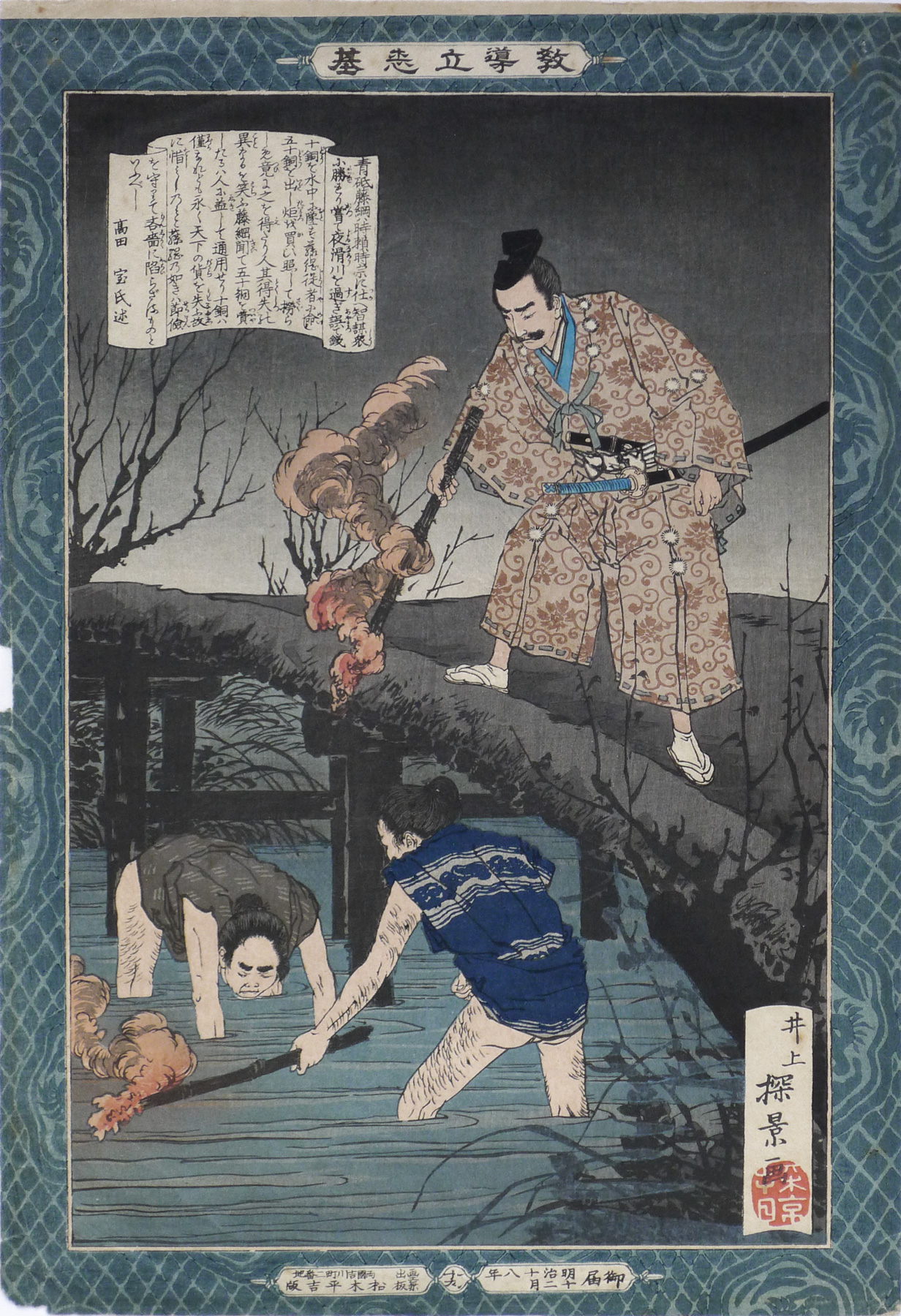

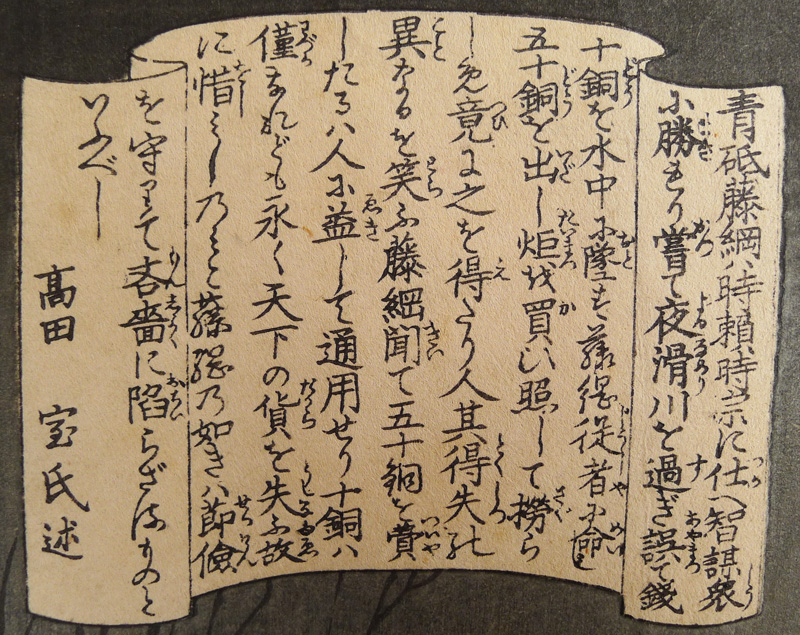
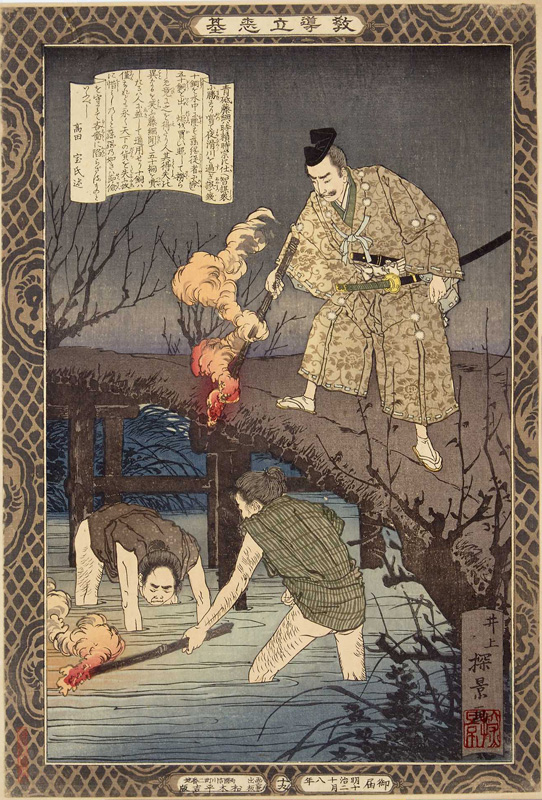
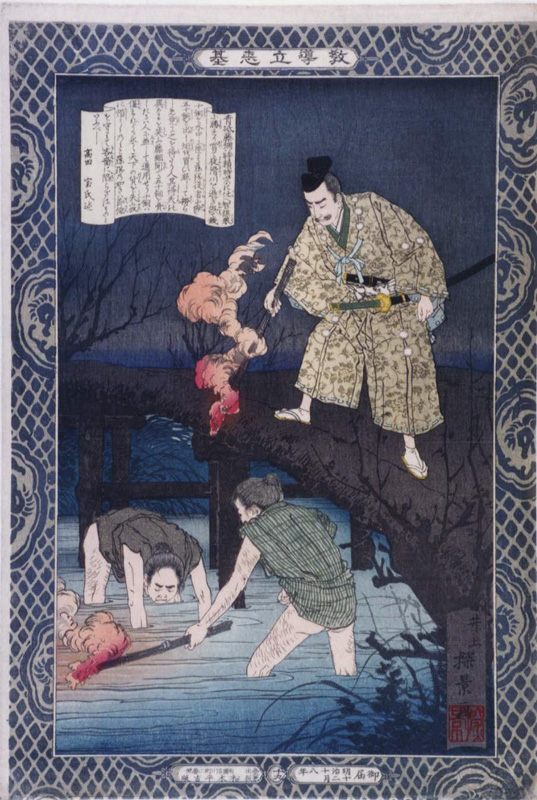
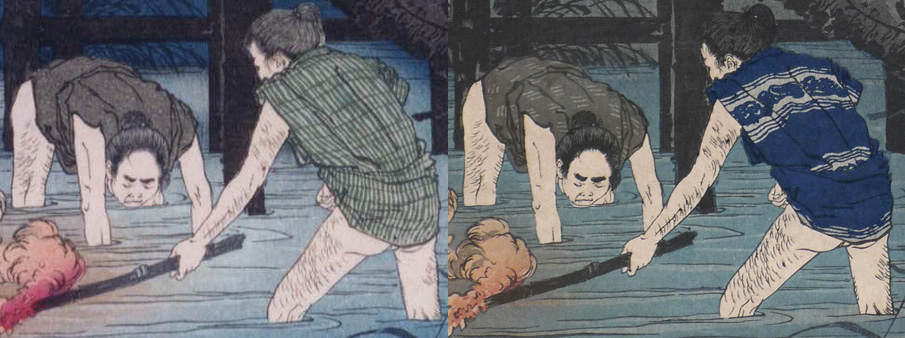
 IHL Cat. #615
IHL Cat. #615